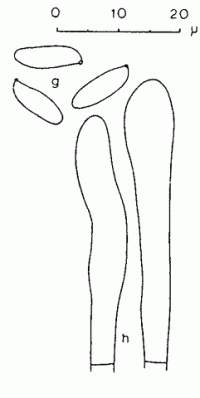|
 Suillus lakei Suillus lakei
SynonymsBoletinus lakei
Boletus lakei
Ixocomus lakei
BiostatusPresent in region - Exotic
Images (click to enlarge)
Caption: Fig. 2 - g, h, S. lakei: g, spores; h, cystidia |
Article: McNabb, R.F.R. (1968). The Boletaceae of New Zealand. New Zealand Journal of Botany 6(2): 137-176 (http://www.rsnz.org/publish/abstracts.php).
Description: PILEUS: convex
to plano-convex, often applanate with reflexed margins when old, 6.5-12 cm diam.,
dry, moist under wet conditions, but not conspicuously mucilaginous, coarsely
fibrillose to squarrose, reddish tints extending from centre to margin, squamules
ochraceous to brown; cuticle a cutis, composed of repent, interwoven, septate
hyphae, hypodermium composed of repent, encrusted hyphae; squamules formed by
aggregation of short-celled, inflated hyphae 9-18 µm. diam., with brownish contents;
margin often incurved and extending beyond pores when young, usually lacerate
and appendiculate. HYMENOPHORE: tubes to 9 mm long, adnate to decurrent, pallid
yellow when young, becoming yellowish brown at maturity; pores concolorous with
tubes, often staining dark reddish brown where damaged, radially elongated,
to 2 mm in longest dimension. STIPE: 3.5-8 cm long, more or less equal, 1.3-3
cm diam., solid, dry, longitudinally striate or reticulate apically, subglabrous
to fibrillose below annulus, concolorous with pores or darker apically, ochraceous
brown basally; glandulae absent; flesh yellow, slowly turning bright green at
base on exposure to air; annulus superior, membranous, conspicuous in young
fruitbodies, white and arachnoid above, squamulose below, often disappearing
at maturity and leaving roughened area on stipe.
SPORES: spore print
yellowish brown (Clay Color); spores pallid melleous, elliptic-subfusiform,
8.4-10.1-(10.7) X 3.l-3.6-(3.9) µm, smooth. HYMENIUM: basidia hyaline, clavate,
18.5-29 X 5.5-8 µm, 2- or 4-spored; cystidia often crowded in groups, hyaline
or encrusted with brown, resinous material, subcylindrical to subclavate, 33-58
X 5-8 µm. HYMENOPHORAL TRAMA: bilateral, of the Boletus subtype; clamp connections
absent. CONTEXT OF PILEUS: yellow, slowly turning brownish on exposure to air,
occasionally bright green above junction of stipe. TASTE AND SMELL: not distinctive.
CHEMICAL REACTIONS: KOH on pileus—dark olive green; on context of pileus—no
reaction or reddening; NH4OH on pileus—deep green; on context—no reaction except
deep green on pores and context immediately above pores.
Habitat: HABITAT: Gregarious under Pseudotsuga.
Notes: S. luteus is common in the exotic coniferous plantations of New Zealand and may be recognised
by the presence of glandulae and a broadly sheathing annulus on the stipe. In
mature fruitbodies growing under wet conditions the annulus may disintegrate
leaving little trace. The first record of the species in this country appears
to be that of Walker (1931).
Suillus lakei is endemic to the west coast of North America where it is typically associated
with Pseudotsuga. In New Zealand it occurs only under P. menziesii.
Smith and Thiers (1964) erected a variety of Suillus lakei, var. pseudopictus,
which differed from the type in the redder and more scaly pileus. On these characters,
New Zealand collections agree most closely with var. pseudopictus. In
the type description of S. lakei, however, Murrill described the pileus
as " . . . fulvous with latericeous tints, appearing testaceous, densely
imbricate-floccose-scaly . . . ". It appears that the differences between
the two varieties are not constant and, for this reason, the above collections
are described under the type variety.
There is some disagreement
as to the specific status of this fungus. Singer (1966) recently considered
S. lakei a synonym of Boletinus amabilis (Peck) Snell, and transferred
the latter species to Suillus. Before this, Singer (1945b) had tentatively
separated the two by differences in spore width, but in the later publication
considered that the range in spore width overlapped to a large extent and that
the differences were largely imaginary. In contrast. Smith and Thiers (1967)
maintained S. lakei and S. amabilis as distinct species on the
grounds of differences in spore size and shape, context colour, cuticular structure,
and habitat. In all New Zealand collections the spores are less than 4 µm. wide
and thus agree with measurements from the type of S. lakei as described
by Smith and Thiers (1964) rather than those obtained by either Singer (1966)
or Smith and Thiers (1967) from the type of S. amabilis. At present it
is considered preferable to regard S. lakei as a distinct species.
S. lakei
may be distinguished by the squarrose, often red-tinted pileus, radially elongated
pores, and annulate stipe. Was first recorded from New Zealand by Rawlings (1958).
Article: Gadgil, P.D. (in association with Dick, M.A.; Hood, I.A.; Pennycook, S.R.) (2005). Fungi on trees and shrubs in New Zealand. Fungi of New Zealand. Ngā Harore o Aotearoa 4: xi + 437 p. Hong Kong: Fungal Diversity Press.
Description: Type: Mycorrhizal Fungi; Description: Basidiomata pileate. Pileus tinted reddish, 60–120 mm in diameter, sprinkled with coarse, ochraceous to brown scales, convex to plano-convex, dry; flesh yellow. Pore surface adnate to decurrent; tubes pale yellow becoming yellowish brown, up to 9 mm long; pores concolorous with tubes, radially elongated, up to 2 mm long. Stipe more or less cylindrical, concolorous with the pores above a membranous white annulus, ochraceous brown below, fibrillose, 35–80 mm long. Basidiospores elliptical, 0-septate, 8–10 × 3–4 μm, smooth, pale yellow.
Distribution: Distribution: Bay of Plenty, Nelson, Buller, Marlborough, North Canterbury, Mid Canterbury, South Canterbury, Otago Lakes, Dunedin, Southland.; 1st Record: Rawlings (1958).
Article: Stevenson, G. (1962) [1961]. The Agaricales of New Zealand: I. Kew Bulletin 15(3): 381–385.
Description: Pileus 10-14 cm. diam., light to medium ochraceous brown, darker at centre, covered with fibrillose scales, pellicle peeling; flesh yellow when first cut, then turning brown, flesh of centre of cap and stipe turning bright green and then darkening almost to indigo. Pores 3-9 mm. long X 1-2 mm. wide, dissepiments thin, pore layer separable. Stipe 2.5 X 3 cm., tapered slightly to rooting base to which was attached a mass of white mycelium binding the litter together; more or less distinct ring, brownish in colour and somewhat scaly below the ring, yellowish and striate above. Spores 11 X 3.5m, ochraceous tawny, thickwalled.
Habitat: under Pseudotsuga menziesii, Ashley Forest
|